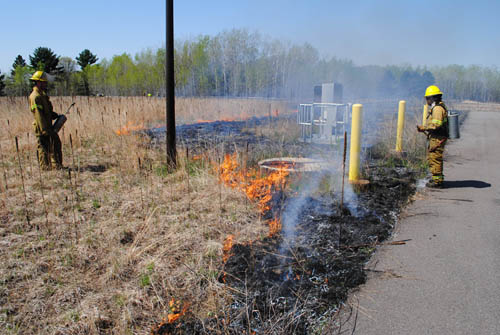Before modern fire suppression, Midwestern prairies and wetlands were subject to extensive wildfires. Fire was such a common natural event that plants native to the Midwest have special adaptations to survive fire and, in fact, benefit from periodic burnings.
 Prescribed burns are today’s equivalent to the fires that once occurred naturally and are an essential tool in managing our existing prairies and wetlands.
Prescribed burns are today’s equivalent to the fires that once occurred naturally and are an essential tool in managing our existing prairies and wetlands.
The Council’s Environmental Services division (MCES) recently conducted a prescribed burn on property in Anoka County where MCES discharges reclaimed water from its East Bethel Water Reclamation Plant, located nearby.
The highly-treated water is discharged through underground pipes and allowed to infiltrate or slowly percolate through soil layers to the groundwater below.
The primary function of the site is to provide an area for high-quality reclaimed water – the term for the specially-treated water produced from wastewater by the treatment plant – to infiltrate into the soil, where it is taken up by plant roots or augments shallow groundwater reserves. The site is home to an 11-acre native grassland, teeming with various species of native wildflowers, pollinators, and birds.
Agency practices sustainability, strives to be good neighbor
 “MCES strives to be a good neighbor throughout the region. Maintaining our landscapes and appropriately communicating with neighbors is a key part of that,” said Environmental Analyst Karen Jensen, who helped oversee the burn.
“MCES strives to be a good neighbor throughout the region. Maintaining our landscapes and appropriately communicating with neighbors is a key part of that,” said Environmental Analyst Karen Jensen, who helped oversee the burn.
“The use of native plant species and the active management of the site with fire demonstrates MCES’s commitment toward being a valued leader and partner in water sustainability.”
MCES manages the division’s properties sustainably by minimizing chemical use and maximizing native Minnesota plant species. “Sustainable land management sometimes involves some unusual activities,” Jensen said.
Fire mirrors natural restoration process
A prescribed burn is designed to “flash” quickly over an area, burning off thatch and other dead vegetation, while leaving the soil, seeds, and seedlings untouched.
Most invasive plant species cannot tolerate fire, so the burn destroys those plants without the use of herbicides. The burn also opens the soil floor to sunlight, allowing last year’s seeds and seedlings to sprout and grow.
Applied Ecological Services (AES) conducted the burn for MCES in early May under permit from the City of East Bethel, and used appropriate fire suppression techniques to ensure a safe burn. Before the burn, MCES staff had reached out to nearby residents to make them aware of the burn and the possibility of drifting smoke. During the burn, MCES staff were also on hand to talk with neighbors about the burn.
The true benefits of the prescribed burn should be evident in July and August – colorful blooms, lush grasses, and teeming wildlife, Jensen said.